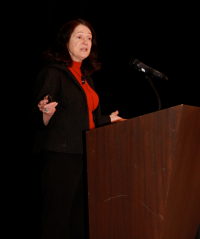August 4
Linking Research and Practice: Strategies for a More Collaborative Health Literacy Community
0 comments
August 4
0 comments

Linda Neuhauser, DrPH, MPH, UC Berkeley School of Public Health
In this presentation, Dr. Neuhauser discussed how the gap between research and practice impacts the success of health literacy initiatives, and offered some strategies for linking the two, as well as examples of successes in this area.
Dr. Neuhauser began by sharing her early experiences trying to give advice to patients. Nobody listened to her science-based advice because they couldn’t relate to it. Her conclusion was that, while we as healthcare providers have messages to send, people have lives to live, and we have to find a way to connect our messages to their lives.
She told the story of how a vaccination program in the West African nation of Mauritania had failed for 20 years. Dr. Neuhauser was sent as part of a medical research team to figure out why. They toured the country, visited villages, talked to the people. Their process was based in design science theory, which focuses on problem solving rather than theory testing. The team was able to solve many of the problems inherent in the program by learning about how the people actually lived and what was important to them.
Finally only one problem remained, how to keep the vaccines cold in the desert heat. It turned out that the camel drivers had the answer: There was a nationwide network of refrigerators for camel vaccines that could easily be used for storing human vaccines as well. The resulting new vaccination program ultimately reached 85% of the population. Dr. Neuhauser’s take-away: Participatory design is key to health programs, and communication is the glue that holds a program together.
She then surveyed the audience and noted that no one present felt that their organization had a high level of adoption of health literacy practices. Most felt that their organization still had a very low level of adoption. This informal survey was representative, according to Dr. Neuhauser: Only 1% of all health literacy research has been translated into action. It has taken 17 years for 14% of the relevant research to make its way into clinical practice; and it takes even longer for these practices to make an impact on the community.
Dr. Neuhauser proposed a new model that differs from the traditional NIH Model of Research Translation, which relies on research and clinical trials for gathering information. Her newer model has researchers working together with practitioners and communities to co-design and evaluate programs.
Dr. Neuhauser then laid out some strategies for putting the newer research-to-practice model in action:
She then went on to give a few examples of successful programs built using this approach, including the California First 5 Kit for New Parents and a wellness program for migrant workers in China. Dr. Neuhauser’s work on these and other programs led her to this conclusion: One of the biggest barriers to health communication is that the audience is not motivated to read the information they get. Involving them in the design process helps bring down this barrier.
In closing, Dr. Neuhauser addressed the perpetual question of how to get buy-in from one’s organization for participatory design. Her advice: Nobody likes to fail. Find a [program] failure in your organization and use it as a reason to try a new approach.
Website: HealthResearchForAction.org
Tags